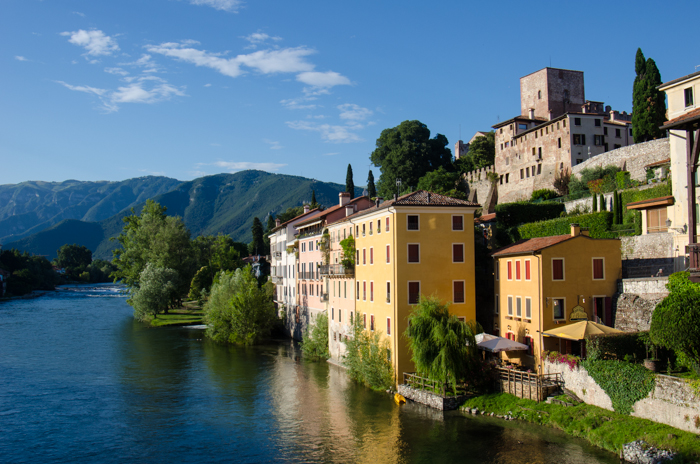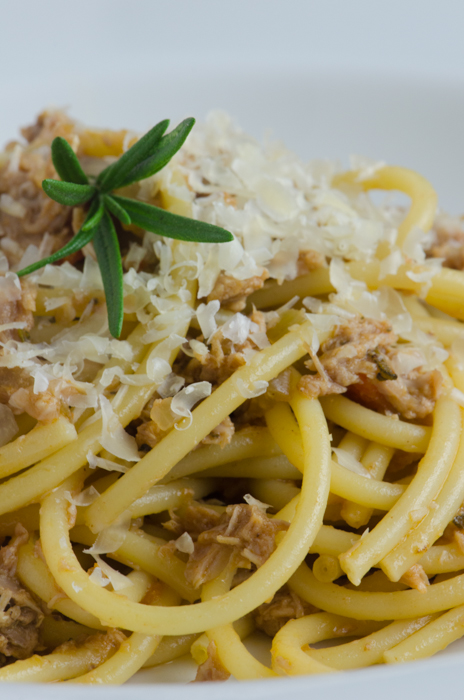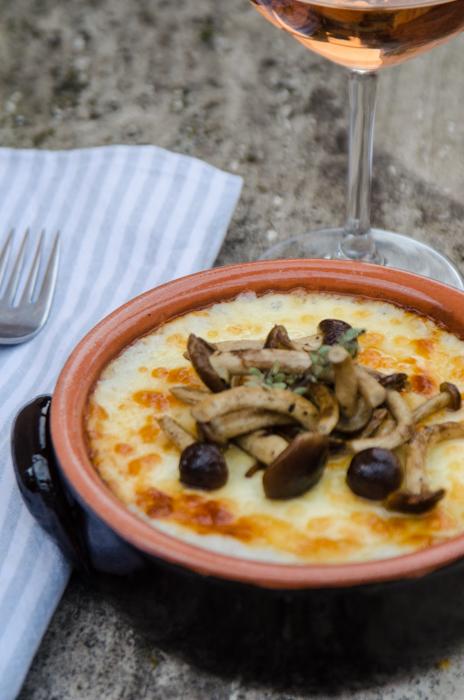 As we explore the Veneto on our Italy walking tours, we see many a corn field, but very rarely fresh corn on the menu; the corn grown here is destined to be dried and ground, and used year round in polenta. A staple here since ancient times, polenta was first made with wild grains from primitive wheats including faro, millet, spelt, and chickpeas, until the Saracens introduced buckwheat, or ‘grana saraceno’ to Italy. This became the most popular grain used for polenta until the 15th or 16th century, when corn, or maize, was introduced.
As we explore the Veneto on our Italy walking tours, we see many a corn field, but very rarely fresh corn on the menu; the corn grown here is destined to be dried and ground, and used year round in polenta. A staple here since ancient times, polenta was first made with wild grains from primitive wheats including faro, millet, spelt, and chickpeas, until the Saracens introduced buckwheat, or ‘grana saraceno’ to Italy. This became the most popular grain used for polenta until the 15th or 16th century, when corn, or maize, was introduced.
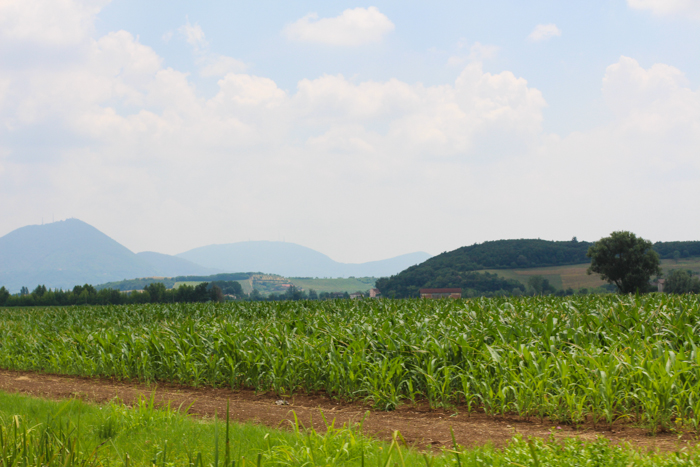 Maize was very easy to cultivate in the lands of Northern Italy, and quickly replaced buckwheat and the other grains. The yield of maize compared to other cereals was much better, making it much more profitable a crop for landowners. Unfortunately, the nutritional value of maize is not as high as the grains it replaced, as it continued to act as a staple in the cuisine of the lower classes in Northern Italy. Today, maize is still the predominate grain used in polenta.
Maize was very easy to cultivate in the lands of Northern Italy, and quickly replaced buckwheat and the other grains. The yield of maize compared to other cereals was much better, making it much more profitable a crop for landowners. Unfortunately, the nutritional value of maize is not as high as the grains it replaced, as it continued to act as a staple in the cuisine of the lower classes in Northern Italy. Today, maize is still the predominate grain used in polenta.
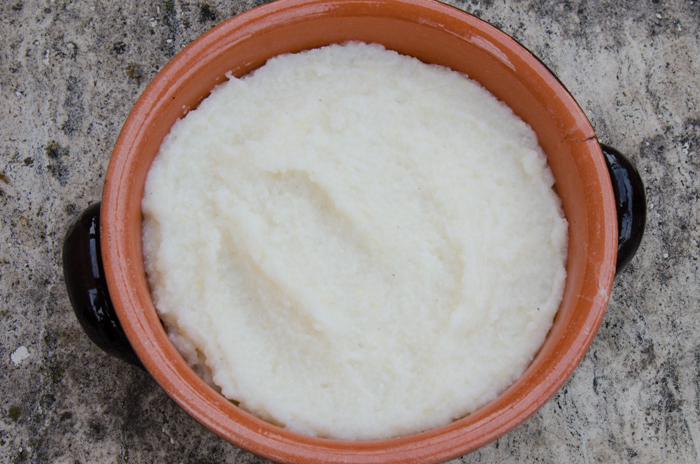 Polenta still plays a major role in the cuisine of the Veneto. It is most commonly prepared with a yellow Marano corn, which is hardy and can be grown in both the plains and mountain foothills of the region. However, until the end of the Second World War, a local white corn variety called Biancoperla was the most highly prized. This corn, which has tapering, elongated cobs with large, bright, pearly-white kernels, was widely planted during the second half of the 19th century. It is know for its fineness and delicate flavor, but has a lower yield than its yellow counterpart.
Polenta still plays a major role in the cuisine of the Veneto. It is most commonly prepared with a yellow Marano corn, which is hardy and can be grown in both the plains and mountain foothills of the region. However, until the end of the Second World War, a local white corn variety called Biancoperla was the most highly prized. This corn, which has tapering, elongated cobs with large, bright, pearly-white kernels, was widely planted during the second half of the 19th century. It is know for its fineness and delicate flavor, but has a lower yield than its yellow counterpart.
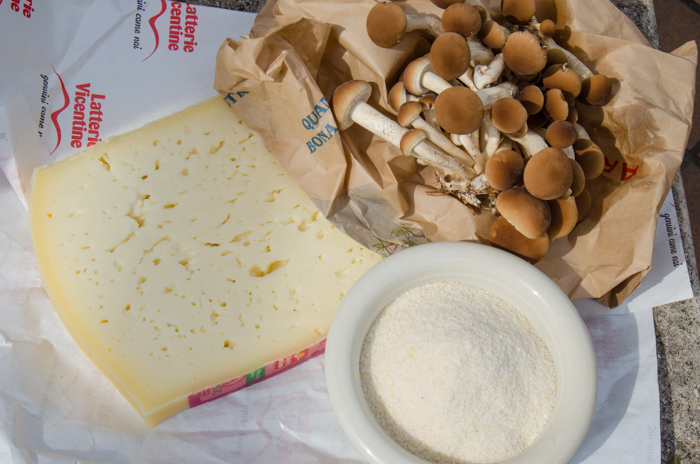 Today, a few dedicated farmers continue to grow this Biancoperla corn varietal. It has been recognized by the Slow Food Presidium in order to ensure the quality of the Biancoperla cornmeal and to promote it to consumers.
Today, a few dedicated farmers continue to grow this Biancoperla corn varietal. It has been recognized by the Slow Food Presidium in order to ensure the quality of the Biancoperla cornmeal and to promote it to consumers.
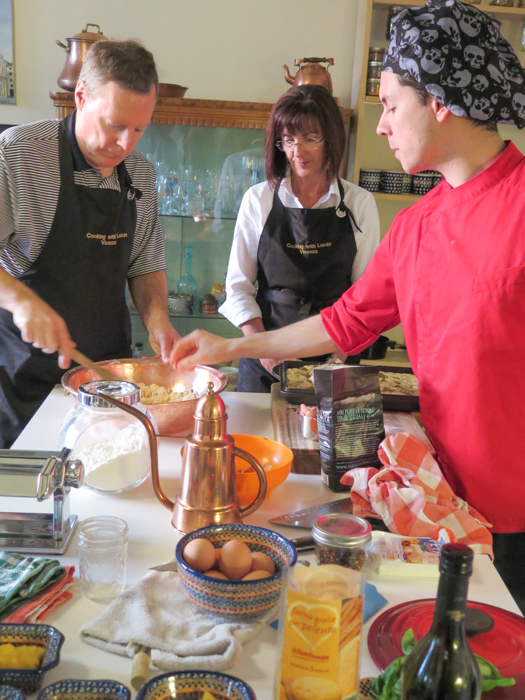 During a recent private walking tour, we enjoyed another wonderful cooking class with Chef Lucas. We made this baked polenta recipe, topped with fresh asiago cheese and mushrooms, but you can envision countless variations! Lucas uses truffles for an elegant spin on this rustic dish.
During a recent private walking tour, we enjoyed another wonderful cooking class with Chef Lucas. We made this baked polenta recipe, topped with fresh asiago cheese and mushrooms, but you can envision countless variations! Lucas uses truffles for an elegant spin on this rustic dish.
I paired this with a crisp Chiaretto rose from the Bardolino wine zone.
Polenta al Forno con Asiago Fresco e Funghi
4 cups water
1 cup biancoperla polenta
Kosher salt
Extra virgin olive oil
10 ounces fresh mushrooms, cleaned and cut into small pieces
1 teaspoon fresh thyme leaves
10 ounces fresh asiago cheese, cut into 1 inch pieces
Preheat the oven to 400°F.
Bring the water to a boil in a medium heavy saucepan over high heat. When boiling, add the polenta in a slow, steady stream through your fingers, whisking constantly so it doesn’t clump up. If you get any lumps, mash them against the side of the pot with a wooden spoon and keep stirring. Lower the heat to as low a simmer as your stove can manage and cook, stirring occasionally, until the polenta is thick and shiny and begins to pull away from the sides of the pan, at least 45 minutes. Season with salt.
You can read my Tips on Making Polenta here.
Divide the polenta between 4 oven-proof serving dishes for individual servings, or place all in one larger oven-proof dish for family style.
Heat the olive oil in a medium saute pan over medium high heat. Add the mushrooms and thyme and cook until soft and slightly browned. Season with salt and remove from heat.
Top the polenta with the cheese cubes, then the mushrooms. Place the polenta in the oven and cook until heated through and brown on top. Serve.
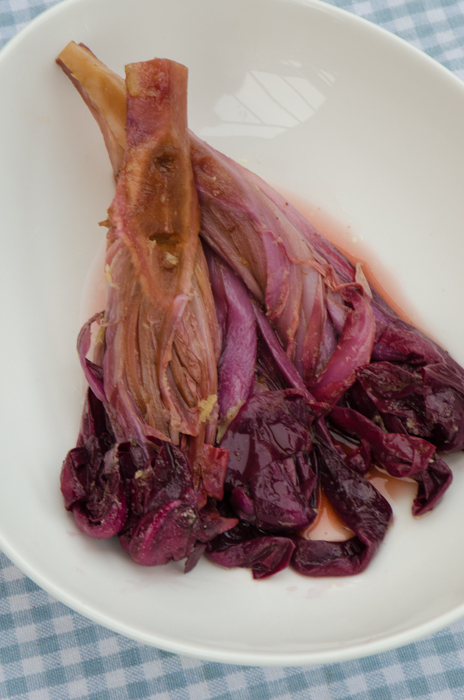 As I return to Italy for our first
As I return to Italy for our first 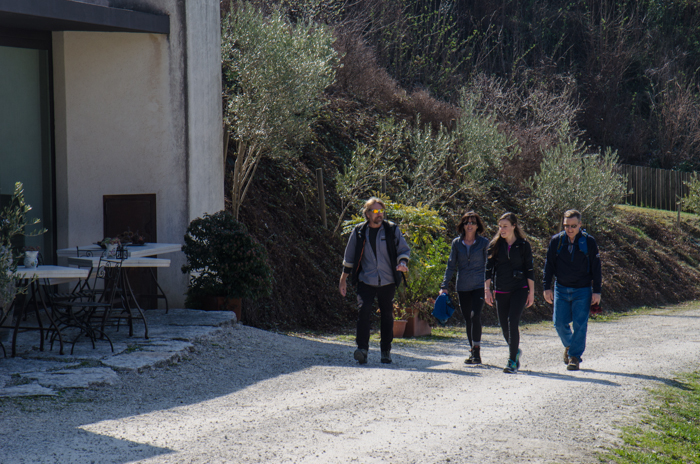
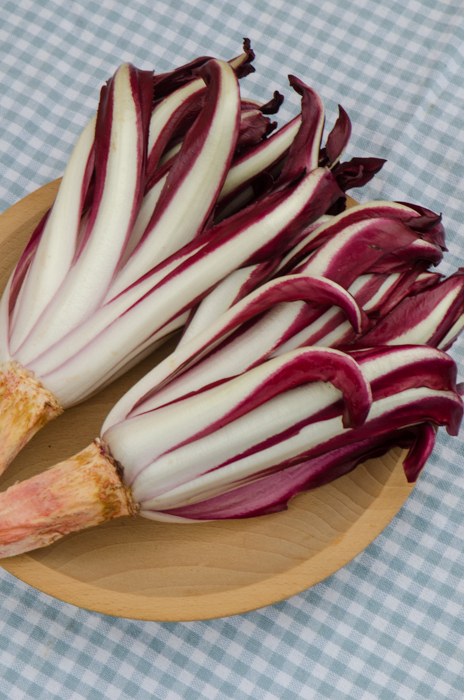 The second type, Tardivo, is more elongated, with a more pronounced vein. Radicchio di Treviso was engineered by a Belgian named Francesco Van Den Borre who lived in Italy and cared for the gardens of the villas in the Veneto. He applied the imbianchiamento techniques used in his country to radicchio plants to create white-veins in the red leaves. This is a forcing, or ‘whitening” process similar to that used for Belgian endive, in which field-harvested plants have their upper halves cut off, and then are replanted in running water. After a few days, the deep red inner ‘heart’ begins to grow, which is sweet and tender, with a touch of the original bitterness still remaining. The older outer leaves are removed and the heart is what you will see in the market.
The second type, Tardivo, is more elongated, with a more pronounced vein. Radicchio di Treviso was engineered by a Belgian named Francesco Van Den Borre who lived in Italy and cared for the gardens of the villas in the Veneto. He applied the imbianchiamento techniques used in his country to radicchio plants to create white-veins in the red leaves. This is a forcing, or ‘whitening” process similar to that used for Belgian endive, in which field-harvested plants have their upper halves cut off, and then are replanted in running water. After a few days, the deep red inner ‘heart’ begins to grow, which is sweet and tender, with a touch of the original bitterness still remaining. The older outer leaves are removed and the heart is what you will see in the market.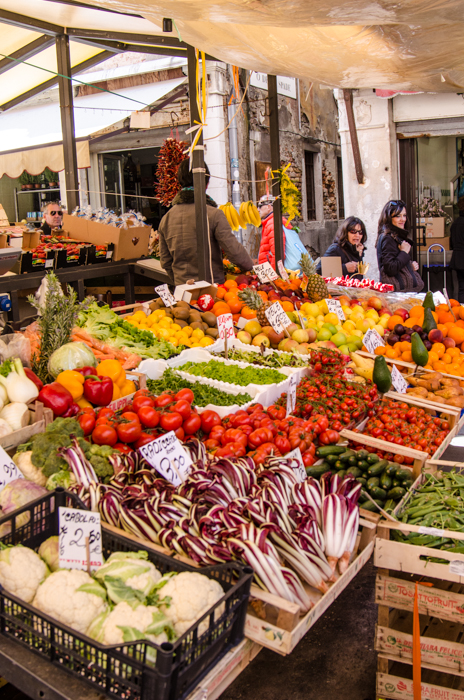
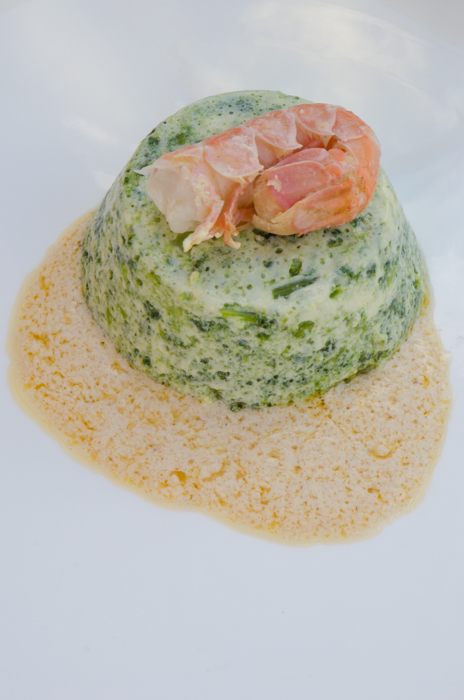 There are countless local varieties of plants that are incorporated into the traditional cuisine and wines of Italy. Due to Italy’s unique geography, these particular species have been isolated to a small area, and may only be found and used within a couple of kilometers. Discovering these very special local specialties is part of any of our
There are countless local varieties of plants that are incorporated into the traditional cuisine and wines of Italy. Due to Italy’s unique geography, these particular species have been isolated to a small area, and may only be found and used within a couple of kilometers. Discovering these very special local specialties is part of any of our 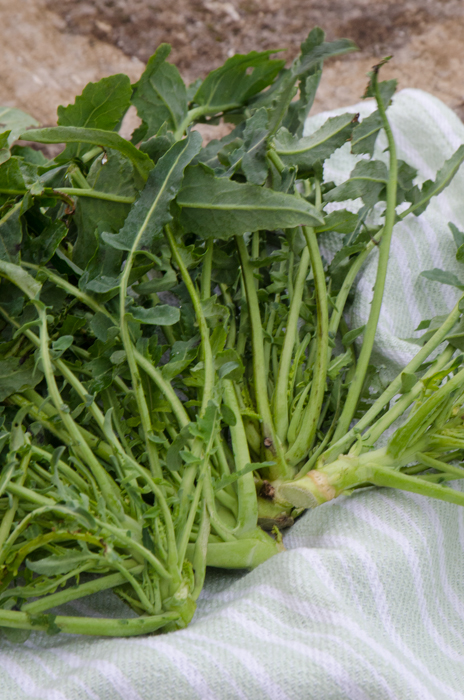 Belonging to the Brassicaceae family, which includes cabbage, cauliflower and kale, fiolaro broccoli has been known in Europe since Roman times. Fiolaro broccoli is unique, as it does not resemble other varieties of broccoli either in form or in taste. Unlike other broccoli, it does not form a flower, but instead produces small secondary shoots along the stem of the plant which are called fioi and have given this plant its name.
Belonging to the Brassicaceae family, which includes cabbage, cauliflower and kale, fiolaro broccoli has been known in Europe since Roman times. Fiolaro broccoli is unique, as it does not resemble other varieties of broccoli either in form or in taste. Unlike other broccoli, it does not form a flower, but instead produces small secondary shoots along the stem of the plant which are called fioi and have given this plant its name.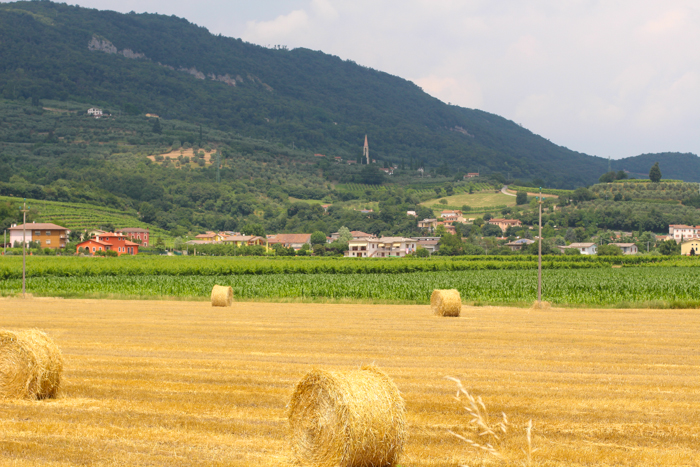 Grown on the hills of Creazzo, just west of Vicenza, at least since the eighteenth century, this plant flourishes in the rich soil on the south slopes in the area of Rivella-Beccodoro-Rampa, where the winter is dry, not too cold, but with brief November frost (-8/10°C) that makes the fiolaro particularly tasty. The plant, which is harvested at the end of February, protects itself from the frost by limiting its water intake, which increases the concentration of salts and sugars.
Grown on the hills of Creazzo, just west of Vicenza, at least since the eighteenth century, this plant flourishes in the rich soil on the south slopes in the area of Rivella-Beccodoro-Rampa, where the winter is dry, not too cold, but with brief November frost (-8/10°C) that makes the fiolaro particularly tasty. The plant, which is harvested at the end of February, protects itself from the frost by limiting its water intake, which increases the concentration of salts and sugars.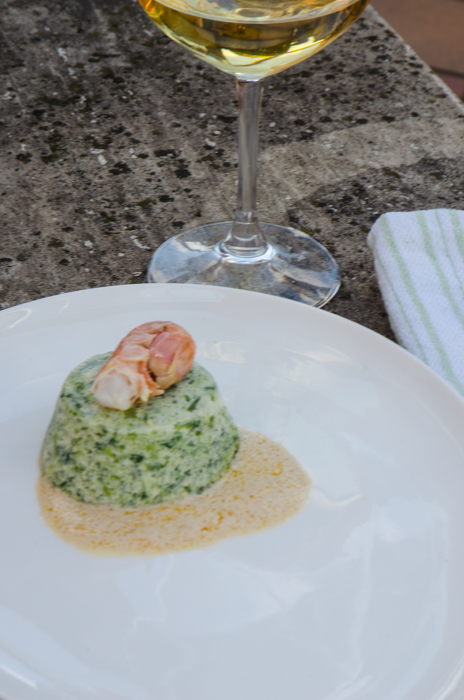 The following recipe is elegant, surprisingly easy, and just as tasty with “regular” broccoli you will be able to find at home. It comes from “Mangiare Veneto: Sette Province in Cucina” (Eat Veneto: Seven Provinces, One Kitchen), by Amedeo Sandri and Maurizio Falloppi. This book offers many recipes for these micro-local specialties of this region, including one recipe for the white asparagus of Bassano, another totally different one for the white asparagus of Sile, nearer Treviso. Locals here in Vicenza would be as likely to gather Fiolaro from the wild, as they would purchase it at the market, then simply saute it with pancetta, onion, olive oil, salt and pepper.
The following recipe is elegant, surprisingly easy, and just as tasty with “regular” broccoli you will be able to find at home. It comes from “Mangiare Veneto: Sette Province in Cucina” (Eat Veneto: Seven Provinces, One Kitchen), by Amedeo Sandri and Maurizio Falloppi. This book offers many recipes for these micro-local specialties of this region, including one recipe for the white asparagus of Bassano, another totally different one for the white asparagus of Sile, nearer Treviso. Locals here in Vicenza would be as likely to gather Fiolaro from the wild, as they would purchase it at the market, then simply saute it with pancetta, onion, olive oil, salt and pepper.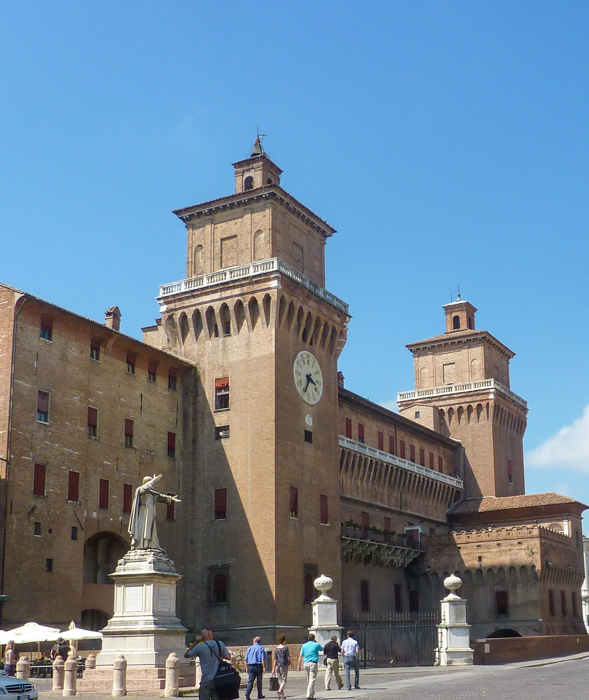 Our
Our 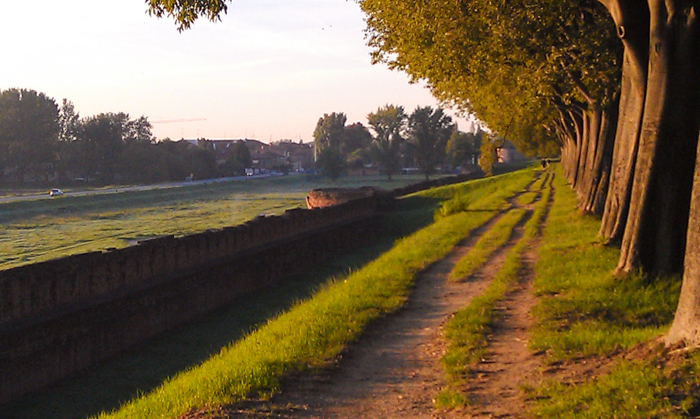 Ferrara is the capital of the
Ferrara is the capital of the 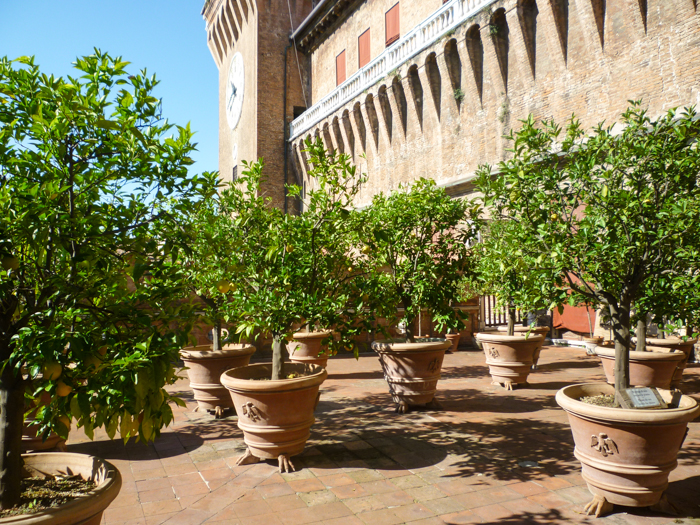
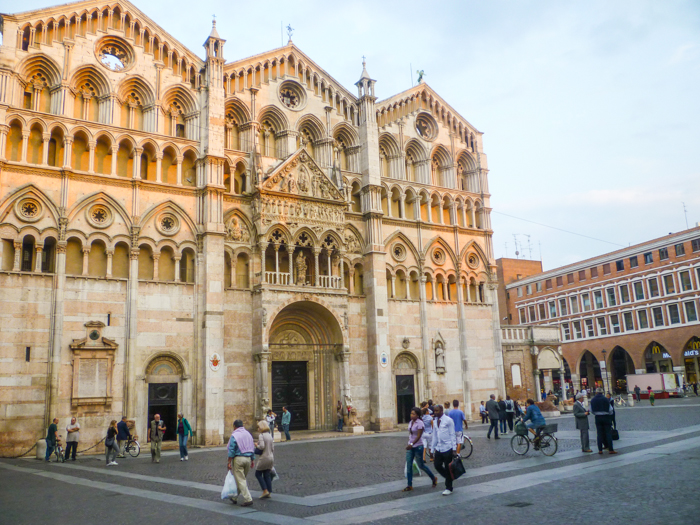 The center of Ferrara is dominated by Romanesque façade of the Cathedral, one of the landmarks of the city. “The Martyrdom of St. Lawrence” by Guercino is among the most important works housed inside the cathedral. The surrounding busy marketplace is the center of activity in this lively city.
The center of Ferrara is dominated by Romanesque façade of the Cathedral, one of the landmarks of the city. “The Martyrdom of St. Lawrence” by Guercino is among the most important works housed inside the cathedral. The surrounding busy marketplace is the center of activity in this lively city.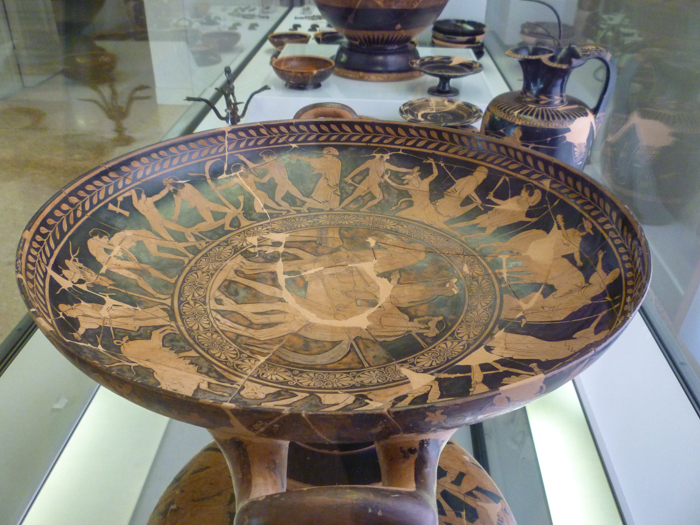 Another spot worth a visit is the Museo Archeologico Nazionale di Ferrara, located in Palazzo Costabili. A very interesting exhibit is dedicated to Spina, an Etruscan port that flourished between the 6th and 3rd centuries BC. Spina was the principal port in northern Adriatic Sea between the late Archaic and Hellenistic periods, and one of the cornerstones of Etruscan presence in northern Italy.
Another spot worth a visit is the Museo Archeologico Nazionale di Ferrara, located in Palazzo Costabili. A very interesting exhibit is dedicated to Spina, an Etruscan port that flourished between the 6th and 3rd centuries BC. Spina was the principal port in northern Adriatic Sea between the late Archaic and Hellenistic periods, and one of the cornerstones of Etruscan presence in northern Italy.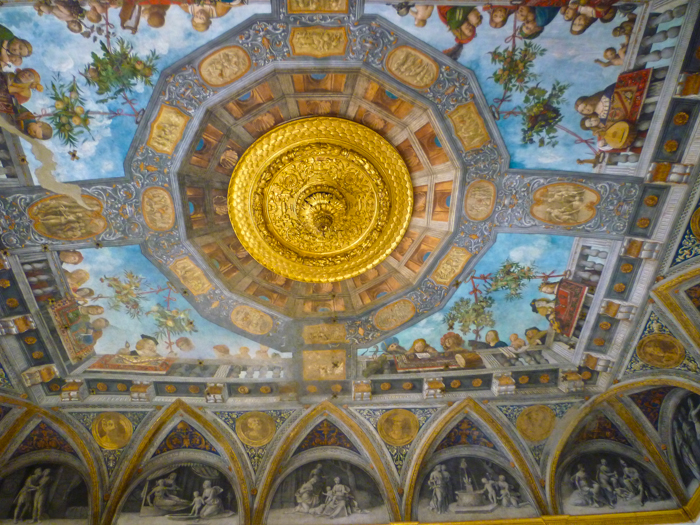 Ferrara is surrounded by some of the best preserved ancient city walls in Italy, dating from the 15th and 16th century. Today, 9 km of cycling and walking paths follow these walls, where you will often find the residents of this “Citta delle Biciclette” enjoying the outdoors along these quiet tree-lined paths.
Ferrara is surrounded by some of the best preserved ancient city walls in Italy, dating from the 15th and 16th century. Today, 9 km of cycling and walking paths follow these walls, where you will often find the residents of this “Citta delle Biciclette” enjoying the outdoors along these quiet tree-lined paths.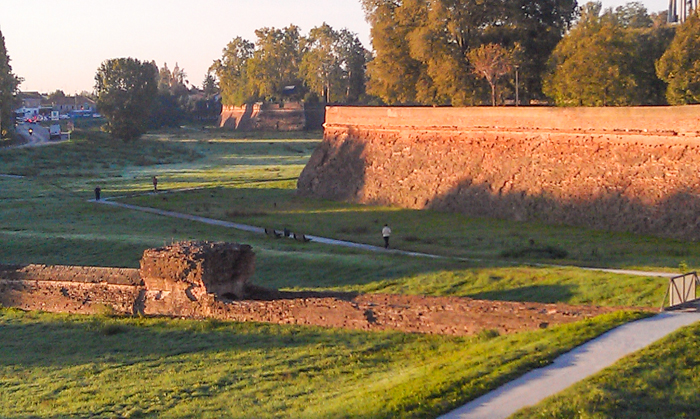
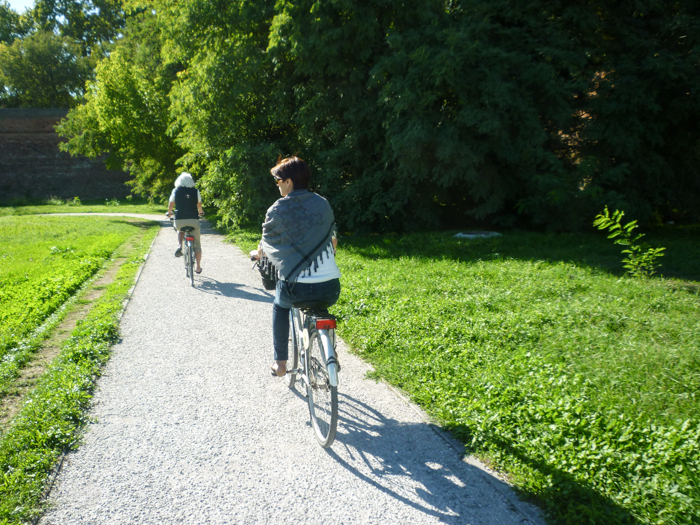 After a nice late afternoon bike ride, we head out for dinner to discover some of the favorite local dishes. The undisputed signature first pasta course in Ferrara is
After a nice late afternoon bike ride, we head out for dinner to discover some of the favorite local dishes. The undisputed signature first pasta course in Ferrara is 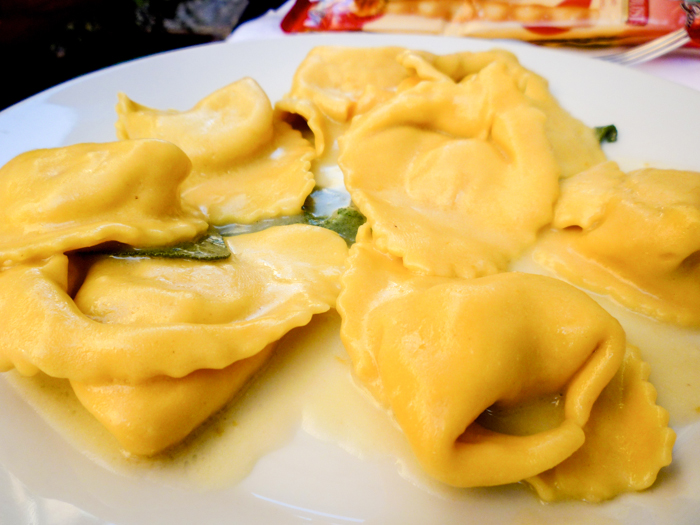 Salama da Sugo is a locally produced pork sausage that is prepared for eating in a very specific way. The sausage is first soaked in warm water overnight in order to soften the outer crust, which is then brushed to clean it. Next, it is wrapped in a cloth and immersed in a pot of water, hanging from a wooden stick so it does not touch the bottom. The water is brought to a low boil, and the sausage simmers here for over four hours. Once cooked, you carefully break the casing and spoon the warm meat over mashed potatoes or polenta.
Salama da Sugo is a locally produced pork sausage that is prepared for eating in a very specific way. The sausage is first soaked in warm water overnight in order to soften the outer crust, which is then brushed to clean it. Next, it is wrapped in a cloth and immersed in a pot of water, hanging from a wooden stick so it does not touch the bottom. The water is brought to a low boil, and the sausage simmers here for over four hours. Once cooked, you carefully break the casing and spoon the warm meat over mashed potatoes or polenta.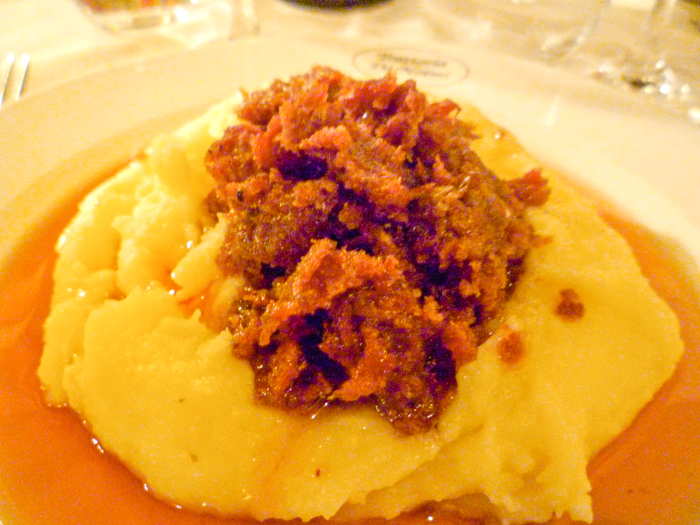 A wonderful dining destination in the heart of the medieval district of Ferrara is the Jewish Ghetto, where the Jewish community of this city was segregated from 1627 to the Unification of Italy (1848 – 1870). Sights here include quaint terracotta houses, the Jewish school, and the Synagogue in Via Mazzini, site of the Jewish Museum. My favorite restaurant here is the Osteria del Ghetto, where you can sample traditional dishes of the community.
A wonderful dining destination in the heart of the medieval district of Ferrara is the Jewish Ghetto, where the Jewish community of this city was segregated from 1627 to the Unification of Italy (1848 – 1870). Sights here include quaint terracotta houses, the Jewish school, and the Synagogue in Via Mazzini, site of the Jewish Museum. My favorite restaurant here is the Osteria del Ghetto, where you can sample traditional dishes of the community.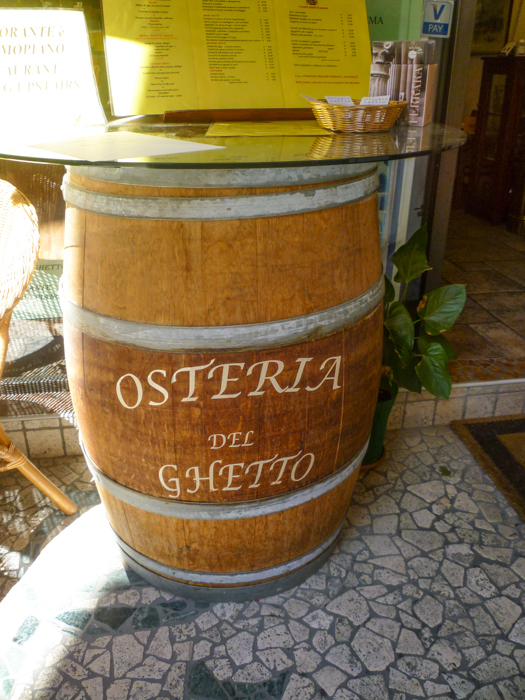 The breadbasket will arrive filled with bread with a very unusual shape, this is coppia Ferrarese (ciupeta), the local specialty bread. This bread dates back over 800 years or more, when rules instructed bakers to produce bread in the shape of scrolls (orletti). Today’s version is a sourdough bread, made from two rolled up ribbons of dough which are united together in the center, leaving the four twisted ends sticking out like a four pointed star. Coppia Ferrarese enjoys PGI (Protected Geographical Identification) recognition by the European Community.
The breadbasket will arrive filled with bread with a very unusual shape, this is coppia Ferrarese (ciupeta), the local specialty bread. This bread dates back over 800 years or more, when rules instructed bakers to produce bread in the shape of scrolls (orletti). Today’s version is a sourdough bread, made from two rolled up ribbons of dough which are united together in the center, leaving the four twisted ends sticking out like a four pointed star. Coppia Ferrarese enjoys PGI (Protected Geographical Identification) recognition by the European Community.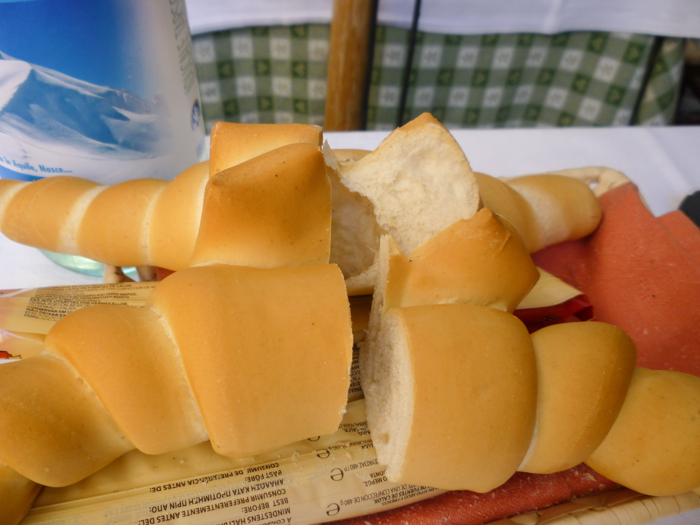 Due to religious restrictions, you would not find pork dishes here, instead, poultry based dishes were common. Here, try the Chicken Braised in Pears, spiced with cinnamon, featuring the local pears found in the orchards surrounding Ferrara.
Due to religious restrictions, you would not find pork dishes here, instead, poultry based dishes were common. Here, try the Chicken Braised in Pears, spiced with cinnamon, featuring the local pears found in the orchards surrounding Ferrara.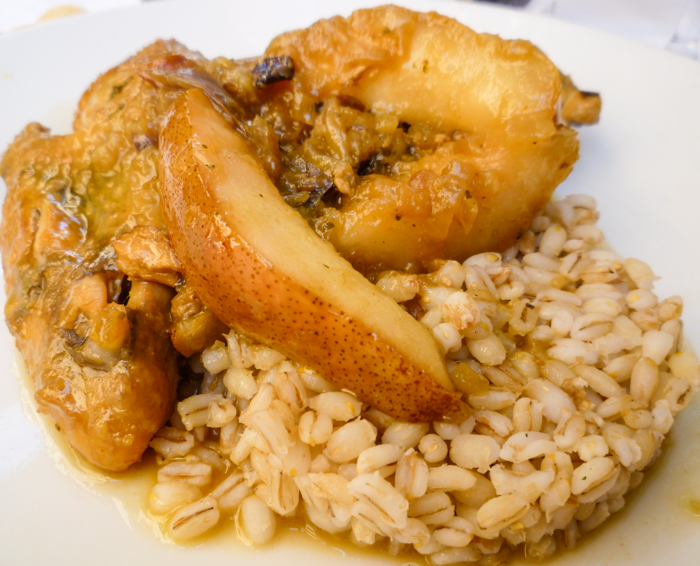 When in Ferrara, I recommend the local wines to accompany your meals. The region of Emilia-Romagna produces quite a bit of wine, but not a lot is exported. You should try a glass of
When in Ferrara, I recommend the local wines to accompany your meals. The region of Emilia-Romagna produces quite a bit of wine, but not a lot is exported. You should try a glass of 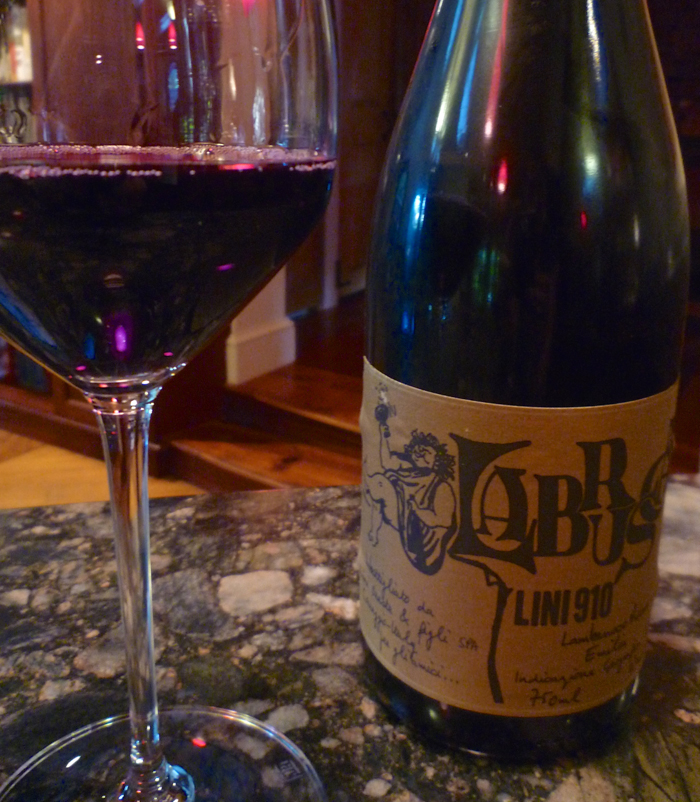 For a white, the local favorite is a Pignoletto. Here in Emilia-Romagna the residents proudly use this name, but DNA analysis has shown that Pignoletto is actually the Grechetto grape grown in Umbria. The best are lively and crisp, and you can find both still and sparkling versions. Finally, the local red wines are made from the Sangiovese grape, the most widely planted grape in Italy, You have no doubt enjoyed Sangiovese based wines before, in your glass of Chianti. Spend your evening in Ferrara enjoying a glass on the Piazza della Cattedrale, watching the sunset reflecting on the historic facade.
For a white, the local favorite is a Pignoletto. Here in Emilia-Romagna the residents proudly use this name, but DNA analysis has shown that Pignoletto is actually the Grechetto grape grown in Umbria. The best are lively and crisp, and you can find both still and sparkling versions. Finally, the local red wines are made from the Sangiovese grape, the most widely planted grape in Italy, You have no doubt enjoyed Sangiovese based wines before, in your glass of Chianti. Spend your evening in Ferrara enjoying a glass on the Piazza della Cattedrale, watching the sunset reflecting on the historic facade.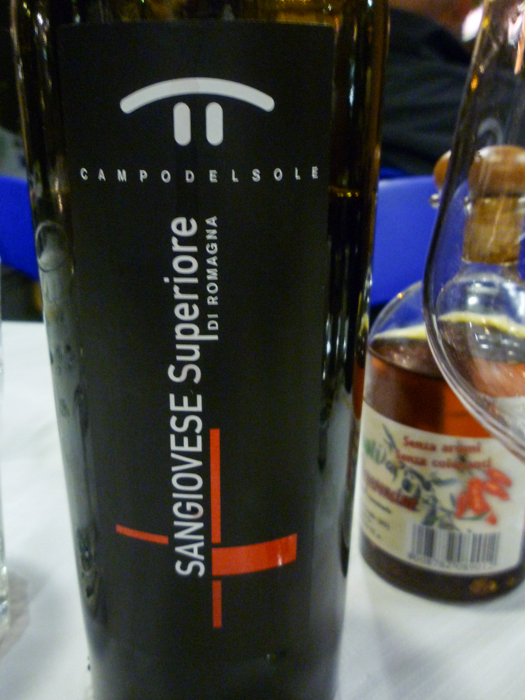
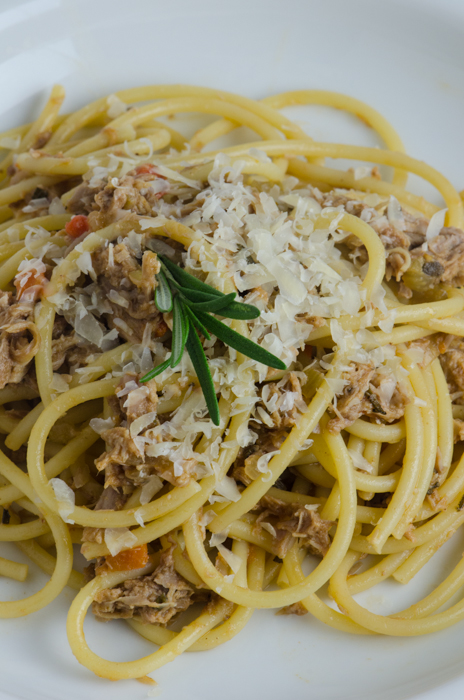 Venetians themselves are not really meat eaters; their watery surroundings naturally drove them to a seafood based cuisine. However, as we move inland from Venice to the mainland on our
Venetians themselves are not really meat eaters; their watery surroundings naturally drove them to a seafood based cuisine. However, as we move inland from Venice to the mainland on our 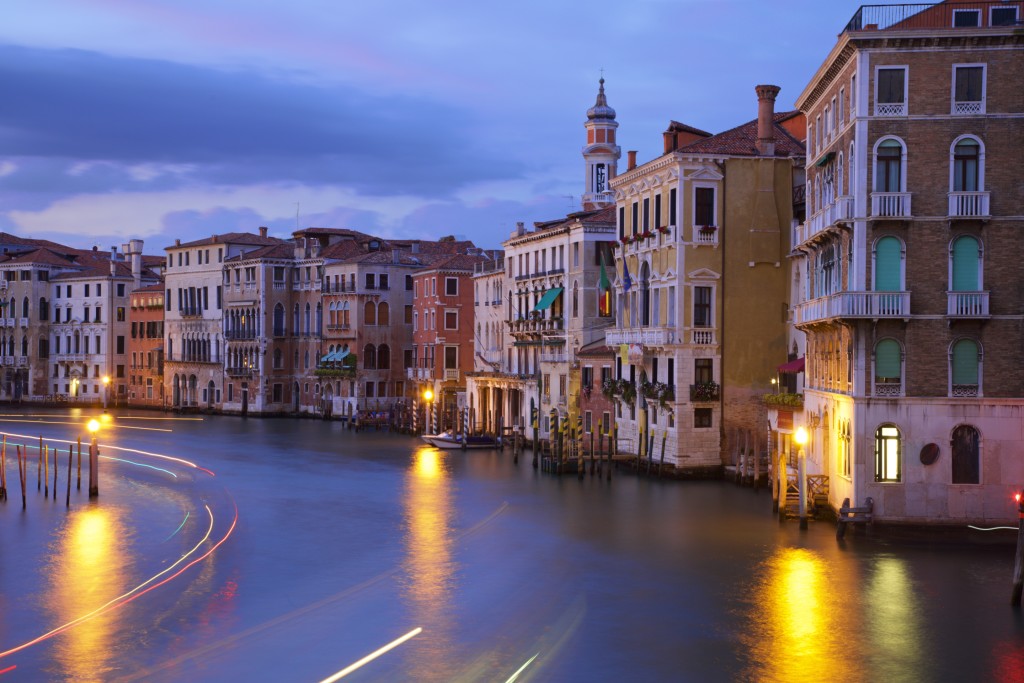 All along the waterways leading to the Venetian lagoon, we see the food products used in the local cuisine, from rice for risottos, to fresh-water fish, to waterfowl. Traditionally there was an enormous variety of water birds that were hunted and used for food. Each would be prepared in a particular way, designed to exhibit (or hide) its particular characteristics. Nowadays, we see recipes that call for “duck”, years ago, you would prepare each particular variety in a slightly different way. The most prized species of duck “germano reale”, the familiar Mallard, even had different preparation techniques for the female (boiled, and used for stock) than the male (roasted). There is a specific recipe for the pintail duck, another for the teal, the tufted duck, the coot, and so forth. Waverly Root describes recipes in which the not-particularly attractive taste of heron and curlew is disguised with a lengthy marinade in white wine, lemon juice, consomme and herbs.
All along the waterways leading to the Venetian lagoon, we see the food products used in the local cuisine, from rice for risottos, to fresh-water fish, to waterfowl. Traditionally there was an enormous variety of water birds that were hunted and used for food. Each would be prepared in a particular way, designed to exhibit (or hide) its particular characteristics. Nowadays, we see recipes that call for “duck”, years ago, you would prepare each particular variety in a slightly different way. The most prized species of duck “germano reale”, the familiar Mallard, even had different preparation techniques for the female (boiled, and used for stock) than the male (roasted). There is a specific recipe for the pintail duck, another for the teal, the tufted duck, the coot, and so forth. Waverly Root describes recipes in which the not-particularly attractive taste of heron and curlew is disguised with a lengthy marinade in white wine, lemon juice, consomme and herbs.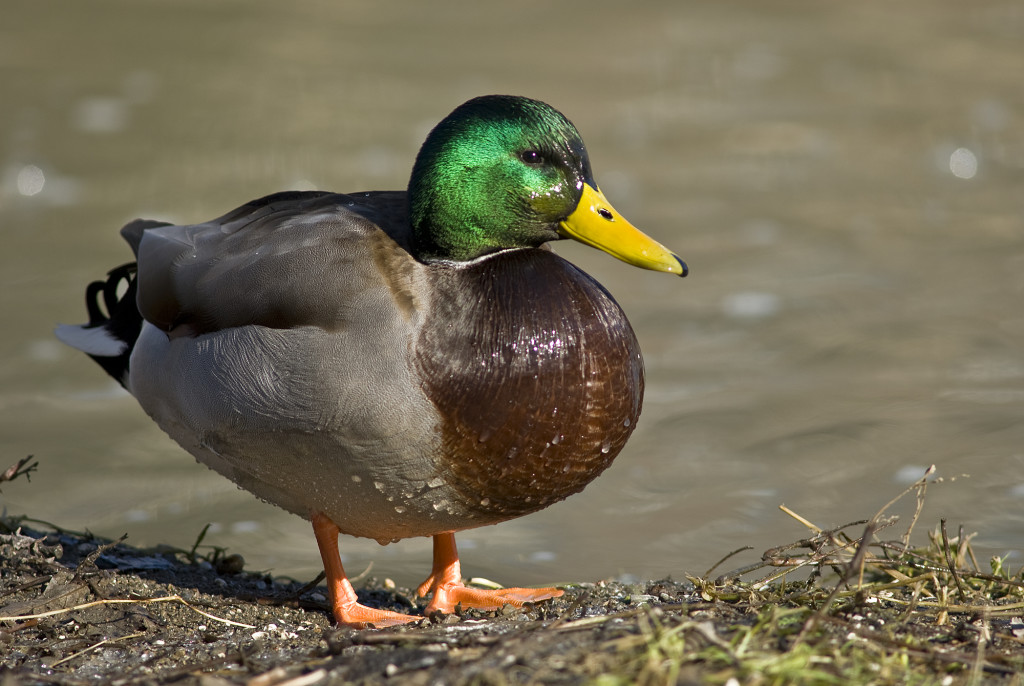 When using meat in a recipe in the Veneto, you will most likely see it chopped up and used in some sort of sauce, rather than served in large pieces as is done in most meat loving regions. Poultry in general is more popular in this region than beef or other meats, undoubtedly due to the availability of waterfowl in the low-lying wetlands of the region. Throughout the area, you will see a meaty duck sauce served in a variety of different ways. In Venice, it might include tomatoes and be served over gnocchi. In Vicenza, it will be served over the favorite local pasta, bigoli, not often seen here in the US, but most closely resembles bucatini, a wide, hollow, spaghetti.
When using meat in a recipe in the Veneto, you will most likely see it chopped up and used in some sort of sauce, rather than served in large pieces as is done in most meat loving regions. Poultry in general is more popular in this region than beef or other meats, undoubtedly due to the availability of waterfowl in the low-lying wetlands of the region. Throughout the area, you will see a meaty duck sauce served in a variety of different ways. In Venice, it might include tomatoes and be served over gnocchi. In Vicenza, it will be served over the favorite local pasta, bigoli, not often seen here in the US, but most closely resembles bucatini, a wide, hollow, spaghetti.